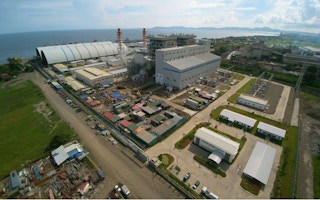Singapore’s central bank has announced two pilot transactions located in the Philippines to test the feasibility of its new concept of using “transition credits” to hasten the early retirement of Asia’s young coal-fired power plants.
To continue reading, subscribe to Eco‑Business.
There's something for everyone. We offer a range of subscription plans.
- Access our stories and receive our Insights Weekly newsletter with the free EB Member plan.
- Unlock unlimited access to our content and archive with EB Circle.
- Publish your content with EB Premium.
Between the two selected coal plants, one of them – the South Luzon Thermal Energy Corporation (SLTEC) plant which started operating commercially only in 2014 – will likely have its decommissioning date brought forward to as early as 2030, with the use of the new class of carbon credits.
The 246-megawatt (MW) plant was scheduled to already have its operating life of up to 50 years halved under a successful Energy Transition Mechanism (ETM) deal in November last year which saw Philippine-based energy group ACEN fully divest its stakes in the facility. The effort to gradually wind down the plant would have seen a reduction of carbon emissions of up to 50 million metric tonnes, according to estimates.
ACEN is Filipino conglomerate Ayala’s energy business arm.
Transition credits, or carbon credits that can be generated from emissions reduced when high-emitting assets like coal-fired power plants (CFPPs) are retired early and replaced with cleaner energy sources, have been mooted by the Monetary Authority of Singapore (MAS) as a complementary financing mechanism to close the economic gap for decommissioning the region’s 5,000 or so power plant units which are below 15 years old on average.
The latest unveiling of the two selected trials follows a working paper that the central bank jointly released with McKinsey & Company proposing the new concept in September. The second pilot project will involve a 200-MW Mindanao coal plant, located in the southern region of the Philippine archipelago.
Speaking at a panel discussion at the COP28 global climate summit in Dubai, Eric Francia, president and chief executive officer of ACEN said the world cannot wait for all coal plants to shut down as late as 2040, and there is a need for “increased ambition.”
“100 per cent of coal plants should shut down by 2040. But 55 per cent of that should be shut down by 2030, relative to 2022 levels,” he said, citing projections by the International Energy Authority.

Signing ceremony for the pilot project to phase out the South Luzon Thermal Energy Corporation coal plant using transition credits. From left: Ravi Menon, managing director of the Monetary Authority of Singapore (MAS); Erica Francia, president & chief executive officer of ACEN Corporation; Ashvin Dayal, senior vice president, Power and Climate, The Rockefeller Foundation. Image: The Rockefeller Foundation
ACEN, as well as the Coal to Clean Credit Initiative (CCCI), a consortium led by the Rockefeller Foundation, will be partnering MAS on the SLTEC project. The pilot will use CCCI’s methodology which is pending approval from carbon credit certifier Verra, following a public consultation that is expected to conclude in mid-January 2024.
Standardised approach for coal phase-out
Separately, MAS announced at COP28 that a new cross-sector Transition Credits Coalition, or Traction, will be convened to identify potential solutions to develop transition credits as a credible financing instrument over a two-year period. The coalition, launched at the COP28 climate summit in Dubai, is made up of 27 entities, including carbon credit standard setters like Gold Standard, environmental non-governmental organisations such as the World Wide Fund for Nature (WWF), as well as the Glasgow Financial Alliance for Net Zero (GFANZ).
Transition Credits Coalition members and knowledge partners
Financial institutions and investment managers
-
Citi; Clifford Capital; Climate Smart Ventures; DBS Bank; GenZero; MUFG; Mizuho Financial Group; OCBC; Sumitomo Mitsui Banking Corporation; Standard Chartered Bank; Temasek; HSBC
Insurance advisors
-
Aon; Howden Insurance Brokers
Exchanges and traders
-
Climate Impact X; Vitol Asia
Foundations
-
The Rockefeller Foundation
Carbon service providers
-
BeZero Carbon; Global Carbon Market Utility; Gold Standard; Sylvera
Non-governmental organisations, multilateral development banks, industry organisations and international organisations
-
Asian Development Bank; Glasgow Financial Alliance for Net Zero, International Emissions Trading Association; International Energy Agency; Multilateral Investment Guarantee Agency, World Wide Fund for Nature (WWF) Singapore
It will draw from the experience of working on the pilots to come up with a standardised approach for shutting down coal plants across countries with differing market circumstances, said an MAS press release.
Appropriate crediting approaches for regulated and deregulated electricity markets as well as ways to mitigate the risks of non-delivery of credits and to boost buyers’ confidence in transition credits will also be looked into, it added.
Speaking at the COP28 Singapore Pavilion, MAS’ managing director Ravi Menon said that when the central bank first put forward the idea of transition credits three months ago, they had “no clue how this was going to take off” and if there were any live coal-fired power plants that were keen to road test the idea.
But ACEN came along and expressed a willingness to see if the different parties can work together to further accelerate the early decommissioning of their South Luzon plant using the transition credits concept, he said.
Francia shared that bringing forward the retirement of the SLTEC plant by a decade means that ACEN will need to start building its planned integrated renewable energy system – a combination of wind and solar farms with battery storage – by 2027. This will require extra financing given that the switch to the new energy system will bring up the levelised cost of electricity by 40 to 50 per cent compared to coal, he said.
For the second pilot project in Mindanao, MAS will partner Asian Development Bank (ADB), which is known for pioneering the ETM concept as a scalable, collaborative initiative to help developing member countries have access to capital that will help them reduce their reliance on coal. Under the ETM, the coal plant, currently owned by the state-controlled Power Sector Assets and Liabilities Management Corporation, is meant to retire in 2026, five years ahead of the end of its power purchase agreement.
Eco-Business has reached out to ADB to find out more details on how it will use transition credits to complement its current aproach. Philippines is one of three countries selected for its ETM pilot, but since 2021, only its Indonesian ETM project has made it past the finish line. The other country that the multilateral bank is testing its ETM in is Vietnam, with Kazakhstan and Pakistan being the two latest additions.
MAS and McKinsey stressed that for transition credits to be considered “high integrity”, they must align with globally recognised standards like the Core Carbon Principles (CCPs), a global benchmark for carbon credit quality by the governance body Integrity Council for the Voluntary Carbon Market (ICVCM). In its press release, MAS said that they will explore ways to align the transition credits with the CCPs in consultation with ICVCM.
‘Reasonable demand’ for transition credits so far
Speaking on the same panel as Francia, Mikkel Larson, CEO of Singapore-based carbon trading platform Climate Impact X (CIX), which is part of the new coalition, said that he has seen a “reasonable demand” for transition credits priced between US$15 to US$17 from corporates and governments, based on the CIX’s demand survey.
“There is no doubt in my mind that it would be massively helpful if more countries do what Singapore just did and announced that with corresponding adjustments, they will invest in the credits,” said Larson.
Just a day before, Singapore senior minister and coordinating minister for national security Teo Chee Hean said that the Singapore government is prepared to offtake transition credits, should they meet the country’s environmental integrity standards.
Larson noted that while the US$15 to US$17 price range helps to anchor the conversation, prices of the credits will vary depending on differing country characteristics and the age of their coal fleets.
“Sometimes you need US$40, sometimes you need US$50. Asia’s coal fleet is on average 14 years old, but in some countries like Bangladesh, it is five years old. And the just transition is a lot harder in some countries,” he said.
Pushing back on the US$15 to US$17 range, Francia hypothesised that while those prices could be sufficient to fill the gap of foregone cash flows from retiring a coal plant early, they do not adequately reflect other costs that arise from replacing coal power with dispatchable and affordable renewable energy, as well as ensuring a just transition that takes into account the communities and workers affected.
“I have the power to shut down the coal plant by 2030 and to replace it with dispatchable renewables. But that is 40 per cent more expensive for the consumers…That needs to be priced in,” said Francia.
For this reason, rather than focusing on voluntary markets, Francia argued that opportunities should be explored for transition credits to be used in compliance markets.
“Executing against Article 6.2 [a United Nations-backed bilateral carbon trading which allows a country to sell carbon credits without counting towards its own national emissions reduction] is critical. It would be great for the Global North, especially Europe, to allow the purchase of these high integrity credits in the Global South,” he said.
The prices of compliance credits under the European Union’s Emissions Trading Scheme has hovered between 70 and 100 Euros (US$76 to US$109) in the past year. While Singapore does not currently have a compliance market, it will likely emerge in the coming years as the city-state’s biggest emitters begin to offset up to 5 per cent of their carbon tax liabilities from 2024. The country’s carbon tax is expected to reach S$50 (US$37) to S$80 (US$60) per tonne by 2030.
Safeguards against non-delivery of credits
The panellists also debated the best approaches to protecting the private sector from performance risks if a plant does not shut down as planned.
Premod Thomas, a senior advisor at Clifford Capital Holdings, a Singapore debt financing firm backed by the country’s state investor Temasek Holdings and also a part of Traction, suggested a “concessional credits backstop”, which investors can fall back on if the transition credits fail to be generated, at least for the first few years.
“That could be a way to start. In time, as it develops the credibility – which I think it should develop with time and experience – that could possibly fall away,” said Thomas.
But Vikram Rich, a senior advisor from the United States-based non-profit Climate Policy Initiative cautioned that this should not become the “de facto approach” and use up already scarce concessional capital from multilateral agencies like the World Bank’s Multilateral Investment Guarantee Agency.
Instead of overrelying on concessional capital through insurance and guarantees, Rich argued that there needs to be “an evolution” in existing risk-mitigation instruments that expands the role of private finance through “quasi-insurance” or “guarantee-type” products.














